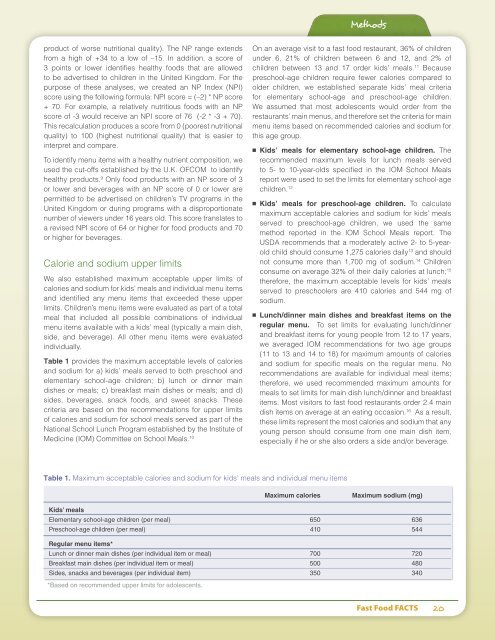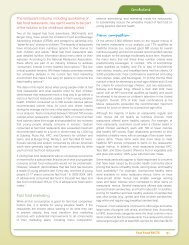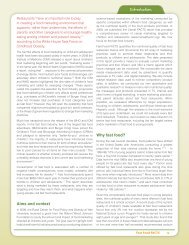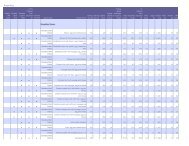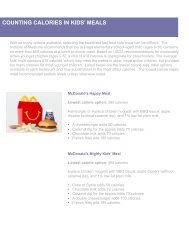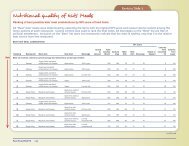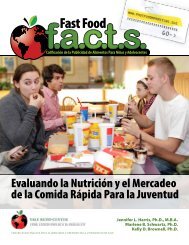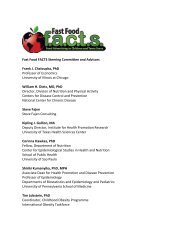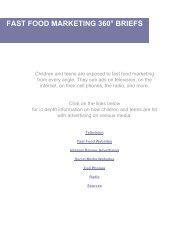Methods Fast food menus and nutritional quality - Fast Food FACTS
Methods Fast food menus and nutritional quality - Fast Food FACTS
Methods Fast food menus and nutritional quality - Fast Food FACTS
You also want an ePaper? Increase the reach of your titles
YUMPU automatically turns print PDFs into web optimized ePapers that Google loves.
product of worse <strong>nutritional</strong> <strong>quality</strong>). The NP range extends<br />
from a high of +34 to a low of –15. In addition, a score of<br />
3 points or lower identifies healthy <strong>food</strong>s that are allowed<br />
to be advertised to children in the United Kingdom. For the<br />
purpose of these analyses, we created an NP Index (NPI)<br />
score using the following formula: NPI score = (–2) * NP score<br />
+ 70. For example, a relatively nutritious <strong>food</strong>s with an NP<br />
score of -3 would receive an NPI score of 76 (-2 * -3 + 70).<br />
This recalculation produces a score from 0 (poorest <strong>nutritional</strong><br />
<strong>quality</strong>) to 100 (highest <strong>nutritional</strong> <strong>quality</strong>) that is easier to<br />
interpret <strong>and</strong> compare.<br />
To identify menu items with a healthy nutrient composition, we<br />
used the cut-offs established by the U.K. OFCOM to identify<br />
healthy products. 9 Only <strong>food</strong> products with an NP score of 3<br />
or lower <strong>and</strong> beverages with an NP score of 0 or lower are<br />
permitted to be advertised on children’s TV programs in the<br />
United Kingdom or during programs with a disproportionate<br />
number of viewers under 16 years old. This score translates to<br />
a revised NPI score of 64 or higher for <strong>food</strong> products <strong>and</strong> 70<br />
or higher for beverages.<br />
Calorie <strong>and</strong> sodium upper limits<br />
We also established maximum acceptable upper limits of<br />
calories <strong>and</strong> sodium for kids’ meals <strong>and</strong> individual menu items<br />
<strong>and</strong> identified any menu items that exceeded these upper<br />
limits. Children’s menu items were evaluated as part of a total<br />
meal that included all possible combinations of individual<br />
menu items available with a kids’ meal (typically a main dish,<br />
side, <strong>and</strong> beverage). All other menu items were evaluated<br />
individually.<br />
Table 1 provides the maximum acceptable levels of calories<br />
<strong>and</strong> sodium for a) kids’ meals served to both preschool <strong>and</strong><br />
elementary school-age children; b) lunch or dinner main<br />
dishes or meals; c) breakfast main dishes or meals; <strong>and</strong> d)<br />
sides, beverages, snack <strong>food</strong>s, <strong>and</strong> sweet snacks. These<br />
criteria are based on the recommendations for upper limits<br />
of calories <strong>and</strong> sodium for school meals served as part of the<br />
National School Lunch Program established by the Institute of<br />
Medicine (IOM) Committee on School Meals. 10<br />
Table 1. Maximum acceptable calories <strong>and</strong> sodium for kids’ meals <strong>and</strong> individual menu items<br />
<strong>Methods</strong><br />
On an average visit to a fast <strong>food</strong> restaurant, 36% of children<br />
under 6, 21% of children between 6 <strong>and</strong> 12, <strong>and</strong> 2% of<br />
children between 13 <strong>and</strong> 17 order kids’ meals. 11 Because<br />
preschool-age children require fewer calories compared to<br />
older children, we established separate kids’ meal criteria<br />
for elementary school-age <strong>and</strong> preschool-age children.<br />
We assumed that most adolescents would order from the<br />
restaurants’ main <strong>menus</strong>, <strong>and</strong> therefore set the criteria for main<br />
menu items based on recommended calories <strong>and</strong> sodium for<br />
this age group.<br />
■ Kids’ meals for elementary school-age children. The<br />
recommended maximum levels for lunch meals served<br />
to 5- to 10-year-olds specified in the IOM School Meals<br />
report were used to set the limits for elementary school-age<br />
children. 12<br />
■ Kids’ meals for preschool-age children. To calculate<br />
maximum acceptable calories <strong>and</strong> sodium for kids’ meals<br />
served to preschool-age children, we used the same<br />
method reported in the IOM School Meals report. The<br />
USDA recommends that a moderately active 2- to 5-yearold<br />
child should consume 1,275 calories daily 13 <strong>and</strong> should<br />
not consume more than 1,700 mg of sodium. 14 Children<br />
consume on average 32% of their daily calories at lunch; 15<br />
therefore, the maximum acceptable levels for kids’ meals<br />
served to preschoolers are 410 calories <strong>and</strong> 544 mg of<br />
sodium.<br />
■ Lunch/dinner main dishes <strong>and</strong> breakfast items on the<br />
regular menu. To set limits for evaluating lunch/dinner<br />
<strong>and</strong> breakfast items for young people from 12 to 17 years,<br />
we averaged IOM recommendations for two age groups<br />
(11 to 13 <strong>and</strong> 14 to 18) for maximum amounts of calories<br />
<strong>and</strong> sodium for specific meals on the regular menu. No<br />
recommendations are available for individual meal items;<br />
therefore, we used recommended maximum amounts for<br />
meals to set limits for main dish lunch/dinner <strong>and</strong> breakfast<br />
items. Most visitors to fast <strong>food</strong> restaurants order 2.4 main<br />
dish items on average at an eating occasion. 16 As a result,<br />
these limits represent the most calories <strong>and</strong> sodium that any<br />
young person should consume from one main dish item,<br />
especially if he or she also orders a side <strong>and</strong>/or beverage.<br />
Maximum calories Maximum sodium (mg)<br />
Kids’ meals<br />
Elementary school-age children (per meal) 650 636<br />
Preschool-age children (per meal) 410 544<br />
Regular menu items*<br />
lunch or dinner main dishes (per individual item or meal) 700 720<br />
Breakfast main dishes (per individual item or meal) 500 480<br />
Sides, snacks <strong>and</strong> beverages (per individual item) 350 340<br />
*Based on recommended upper limits for adolescents.<br />
<strong>Fast</strong> <strong>Food</strong> <strong>FACTS</strong> 20


